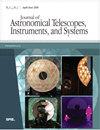Development of the focal-plane CMOS detector for the GEO-X mission
IF 3.1
3区 工程技术
Q2 ENGINEERING, AEROSPACE
Journal of Astronomical Telescopes Instruments and Systems
Pub Date : 2023-12-01
DOI:10.1117/1.jatis.10.1.016001
引用次数: 0
Abstract
We report a development status of a focal plane detector for the GEO-X (GEOspace X-ray imager) mission that will perform soft X-ray (≤2 keV) imaging spectroscopy of Earth’s magnetosphere from a micro satellite. The mission instrument consists of a microelectromechanical systems (MEMS) X-ray mirror and a focal plane detector. A sensor with fine positional resolution and moderate energy resolution in the energy band of 0.3 to 2 keV is required. Because the observing target is the magnetosphere around the day-side Earth, the visible-light background must be decreased by shortening the integration time for readout. To satisfy the above requirements, a high-speed X-ray CMOS sensor is being evaluated as a primary candidate for the detector. Irradiating the flight candidate sensor with monochromatic X-rays, we obtained the energy resolution of 205 eV (FWHM) at 6 keV by cooling the devices to −15°C. Radiation tolerance of the sensor, especially in terms of total dose effect, is investigated with 100 MeV proton. The amount of degradation of energy resolution is <50 eV up to 10 krad, which ensures that we will be able to track and calibrate the change of the line width in orbit.为 GEO-X 飞行任务开发焦平面 CMOS 探测器
我们报告了用于 GEO-X(地球同步轨道空间 X 射线成像仪)任务的焦平面探测器的开发情况,该任务将从一颗微型卫星上对地球磁层进行软 X 射线(≤2 千伏)成像分光。该飞行任务的仪器由一个微电子机械系统(MEMS)X 射线镜和一个焦平面探测器组成。要求传感器在 0.3 至 2 千伏的能带内具有精细的位置分辨率和中等的能量分辨率。由于观测目标是日面地球周围的磁层,因此必须通过缩短读出积分时间来减少可见光背景。为了满足上述要求,目前正在评估一种高速 X 射线 CMOS 传感器,作为探测器的主要候选器件。我们用单色 X 射线辐照飞行候选传感器,通过将器件冷却到 -15°C 获得了 6 keV 时 205 eV(FWHM)的能量分辨率。我们用 100 MeV 质子对传感器的辐射耐受性,特别是总剂量效应进行了研究。能量分辨率在 10 krad 以下的衰减量小于 50 eV,这确保我们能够跟踪和校准轨道上的线宽变化。
本文章由计算机程序翻译,如有差异,请以英文原文为准。
求助全文
约1分钟内获得全文
求助全文
来源期刊

Journal of Astronomical Telescopes Instruments and Systems
Engineering-Mechanical Engineering
CiteScore
4.40
自引率
13.00%
发文量
119
期刊介绍:
The Journal of Astronomical Telescopes, Instruments, and Systems publishes peer-reviewed papers reporting on original research in the development, testing, and application of telescopes, instrumentation, techniques, and systems for ground- and space-based astronomy.
 求助内容:
求助内容: 应助结果提醒方式:
应助结果提醒方式:


